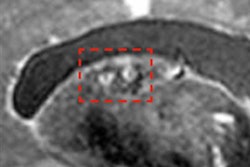
It may be a while before 7-tesla MRI is commonly used in imaging facilities around the world, but if and when the ultrahigh-field magnets become standard protocol, patients are expected to handle examinations with relative ease, Italian researchers have found.
Researchers at the University of Pisa discovered that 7-tesla MRI was well tolerated with no excessive discomfort for subjects. The incidence of adverse effects with the ultrahigh-field magnet was similar to what patients experience with 1.5-tesla and 3-tesla systems.
Lead author Dr. Mirco Cosottini and colleagues commented that the results provide "further evidence supporting the acceptance of 7-tesla, ultrahigh-field MR systems in a clinical research environment."
For the most part, 7-tesla MRI has been used as an investigational device for research projects with little utilization in the clinical setting. In an email to AuntMinnieEurope.com, Cosottini estimated there are approximately 50 ultrahigh-field MRI scanners installed around the world for research purpose. One of those systems (Imago7, GE Healthcare) is installed at the University of Pisa.
"In the world, there is limited experience on the application of ultrahigh-field [MRI] to humans," Cosottini said. "In order to establish the role of 7-tesla MRI for clinical application, we have to investigate the added diagnostic value of ultrahigh-field MRI and the safety and tolerability of the exposure to ultrahigh-field magnetic strength."
Risk limits
The gathering of reliable information on the potential side effects of 7-tesla is important, because, in Europe only clinical systems of 4-tesla or less are considered "without significant risk," according to the International Electro Technical Commission. By comparison, the U.S. Food and Drug Administration (FDA) believes there is no significant risk to patients with clinical MRI systems of 8-tesla or less.
Cosottini and colleagues have published their findings in the August issue of European Radiology (Eur Rad, August 2014, Vol. 24:8, pp. 1923-1928), and they have also published about their research into the potential diagnostic capabilities of ultrahigh-field MRI.
Their study used 7-tesla MRI to evaluate the anatomy of the substantia nigra region of the brain, which is linked to Parkinson's disease. Seven-tesla MRI provided enhanced details of the substantia nigra and its inner workings with the hope that the information might improve early detection of Parkinson's (Radiology, June 2014, Vol. 271:3, pp. 831-838).
In this most recent study, 180 subjects received a 7-tesla MRI brain scan at the University of Pisa. The cohort included 105 healthy volunteers (62 males, 43 females, with a mean age 40 years ±14 years, range 18 to 74 years) and 75 patients diagnosed with neurodegenerative disorders (39 males, 36 females, with mean age 61 years ± 12 years, range 34 to 84 years).
All the subjects were screened for contraindications, such as permanent medical devices or metal in the body, and were informed about possible reactions, such as claustrophobia, dizziness, metallic taste, noise, and muscle reactions.
Imaging protocol
Participants were placed in a headfirst supine position for brain imaging, with his or her head just outside the magnet bore, where the magnetic field is approximately 2-tesla. They then were glided very slowly into the bore at 2 cm per second.
While in the ultrahigh-field MRI, researchers used several imaging techniques, including gradient echo, echo planar, fast spin echo, inversion recovery, and time-of-flight angiography. Total image acquisition time was approximately one hour, ranging from 55 to 70 minutes.
Of the 180 participants, 92 individuals (51%) reported at least one side effect, but no serious adverse event was reported and no one requested that the scan be stopped.
While the gantry was in motion, vertigo was the most common adverse effect mentioned. It was cited by 46 people (26%), followed by a metallic taste by 12 individuals (7%).
"The higher rate of vertigo, with respect to conventional magnets, is due to the higher magnetic field strength and it is probably related to magneto dynamic effects on labyrinthine fluids that enhance during movements within the magnet," Cosottini said.
When the gantry was motionless, only 16 people (9%) mentioned vertigo as a problem, while only four people (2%) complained of nausea.
During the imaging process, the most frequently mentioned adverse effect was noise, as that annoyance was cited by 25 people (14%).
| Adverse effects reported by patients | |
| Adverse effects | Percentage |
| At least one side effect | 51% |
| Vertigo with gantry in motion | 26% |
| Metallic taste with gantry in motion | 7% |
| Too much noise during scans | 14% |
| Same comfort with 7T as with 1.5T or 3T | 83% |
| More comfort with 7T | 6% |
| Less comfort with 7T | 11% |
Healthy vs. patients
Cosottini and colleagues also found that the incidence of side effects were the same for healthy study participants and individuals with neurodegenerative conditions, as well for men and women.
In addition, a greater number of younger subjects (37 ±14 years) reported no adverse effects than older participants (49 ±18 years), who reported at least one side effect.
The study also compared experiences of 7-tesla MRI with 128 people who also had undergone 1.5-tesla or 3-tesla MRI scans. (Fifty-two people previously never had an MRI exam.)
There were 107 individuals (83%) who said the ultrahigh-field MRI scan was identical to lower-field MRI exams, 14 people (11%) who found the 7-tesla MRI to be less comfortable, and eight subjects (6%) who said the ultrahigh-field MRI was more comfortable.
Excessive noise
Half of the 14 people who were less comfortable cited scanner noise as the reason, followed by five participants who said the exam was too long and two subjects with vertigo.
The issue of perceived excessive noise, the authors wrote, "could be attenuated by better patient positioning and padding, by the application of more effective earplug devices, and by designing MR sequences that produce less noise."
Interestingly, Cosottini and colleagues also noted subjects' discomfort decreased in relation to the increased experience of the clinician handling the exam. For example, a slower speed by which a patient is glided into the ultrahigh-field magnet helped to reduce the potential for vertigo.
"One of the main operational [indicators] is that improved experience and confidence of the operators in informing the subjects and performing ultrahigh-field examinations contributed to reduce their expectancy of complications and the subjective discomfort of patients," Cosottini said.
The authors concluded that ultrahigh-field MRI is "practicable. It demonstrates the low incidence of side effects and concludes that ultrahigh-field examinations are well tolerated without excessive discomfort requiring interruption of the examination."
They plan to continue their research in 7-tesla MRI. "With the collaboration of colleagues, physics, and engineers, we are monitoring the absorbed radiofrequency and its distribution in the head during ultrahigh-frequency MR examinations in order to assess the safety and to extend the application of this technique to younger patients," Cosottini noted.


















